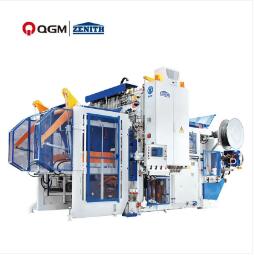How brick making machine works
2024-10-12
A brick-making machine works by automating the process of producing bricks from raw materials such as clay, concrete, or fly ash. It involves several steps, including material preparation, mixing, molding, and curing. Here’s a breakdown of how a typical brick-making machine works:

1. Raw Material Preparation
- Input Materials: The machine uses raw materials like clay, sand, cement, fly ash, or concrete. These materials are stored in hoppers or silos before being fed into the machine.
- Proportioning: The machine is designed to measure the correct proportion of each material. This ensures consistency in brick quality.
- Feeding: Raw materials are conveyed to the mixing chamber via a feeding system, such as a conveyor belt or a screw feeder.
2. Mixing
- Blending the Materials: Once the raw materials are in the mixing chamber, they are mixed thoroughly. Water is often added at this stage to achieve the desired consistency for molding.
- Homogenization: The machine ensures that the mixture is homogenous, with uniform distribution of water and additives throughout the material.
3. Molding
- Filling the Mold: The well-mixed material is fed into molds or dies where it takes the shape of a brick. The mold’s shape determines the size and type of brick produced.
- Compaction: The machine uses hydraulic pressure or vibration to compact the material in the mold. This ensures the brick is dense, well-formed, and strong. Depending on the machine, vibration, compression, or both methods may be used.
- Ejection: After compaction, the formed bricks are ejected from the mold and transferred to a conveyor belt or pallet for the next stage.
4. Curing (for concrete and fly ash bricks)
- Drying or Steam Curing: For certain types of bricks like concrete or fly ash bricks, curing is essential to gain strength. Bricks are either air-dried or subjected to steam curing, where they are kept in a controlled environment with the right temperature and humidity levels.
- Kiln Firing (for clay bricks): In the case of traditional clay bricks, after molding, the bricks are fired in a kiln at high temperatures to harden them. This process also enhances their durability and resistance to weathering.
5. Stacking and Packaging
- Automatic Stacking: Many modern brick-making machines have automated systems that stack the bricks once they have been molded and partially cured. This helps in preparing the bricks for transport or storage.
- Packaging: Once the bricks have completed the curing process, they are packaged or bundled together for transport to construction sites or retail stores.
Types of Brick-Making Machines
- Manual Machines: These machines require manual labor to operate, ideal for small-scale or less mechanized operations.
- Semi-Automatic Machines: These machines automate some parts of the process, such as feeding, compaction, and ejection, while other processes may need manual handling.
- Fully Automatic Machines: These machines automate the entire process, from raw material feeding to brick ejection and stacking. They are highly efficient and ideal for large-scale brick production.
Key Features of a Brick-Making Machine
- Hydraulic or Mechanical Pressure: The machine uses either hydraulic or mechanical pressure to compact the material and shape the brick.
- Mold Variety: Machines come with interchangeable molds, allowing the production of different brick types, such as hollow bricks, solid bricks, and paving blocks.
- Vibration System: To enhance compaction, many machines use vibration to ensure the mixture settles evenly within the mold.
- Control Panel: Fully automated machines come with a computerized control panel that manages the entire production process, ensuring consistency and efficiency.
Conclusion
A brick-making machine simplifies and speeds up the process of producing high-quality bricks by automating material mixing, molding, and curing. Whether it's clay bricks, concrete bricks, or fly ash bricks, these machines are essential in the construction industry for large-scale, efficient brick production.


